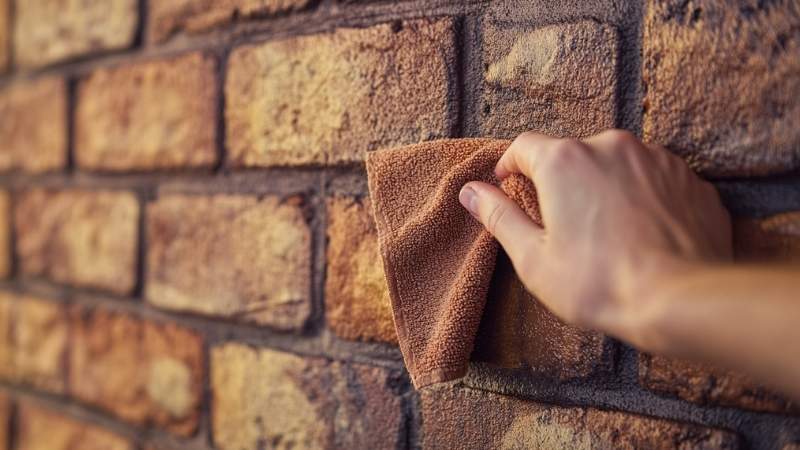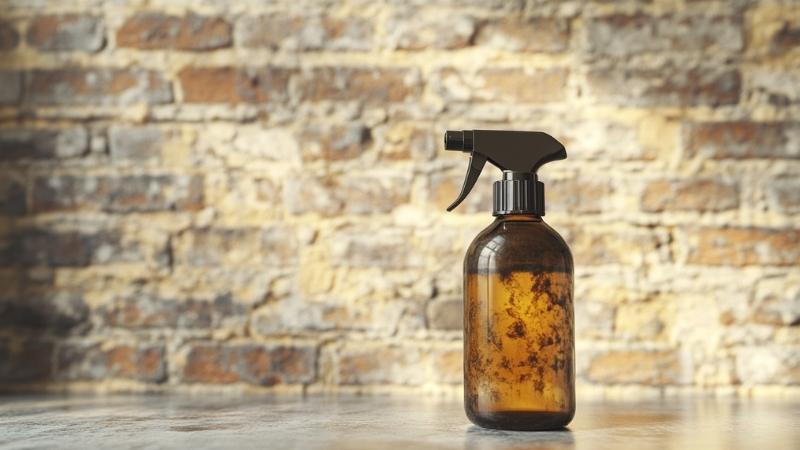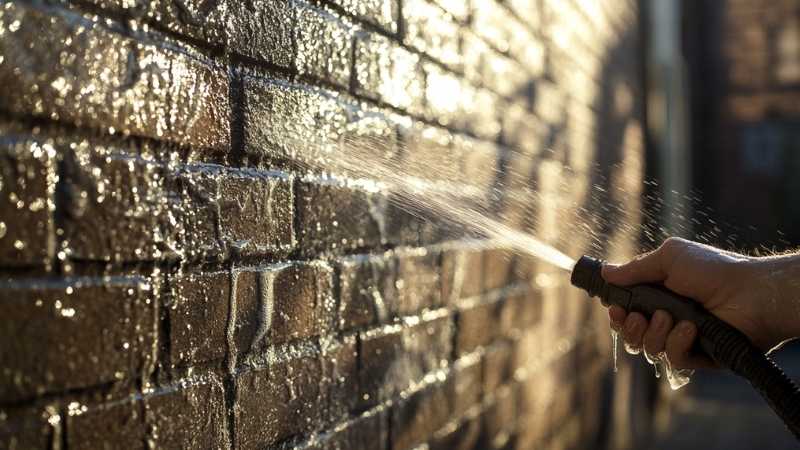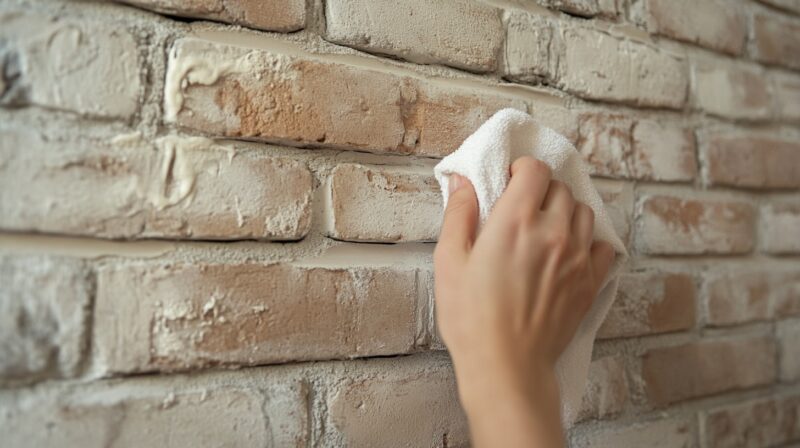Brick walls add character and charm to any home, but over time, dirt, dust, and stains can make them look dull and aged. Whether it’s inside your living room or on the exterior of your house, brick needs regular cleaning to stay in top shape. The good news? Cleaning a brick wall isn’t complicated—you just need the right approach and a little effort.
If you’re looking for installation tips for thin brick, you can check out the helpful guide at RealThinBrick.com. It’s packed with step-by-step advice to ensure a smooth and successful brick installation.
But once your brick wall is in place, proper maintenance is key to keeping it looking great for years to come. That’s why we’ve put together these simple and effective cleaning tips to help you maintain your brick walls effortlessly.
From quick dusting methods to deeper cleaning techniques, this guide will show you exactly how to remove dirt, stains, and even moss from your bricks. No need for fancy tools—just a few household ingredients and a little elbow grease will do the trick. Let’s get started!
1. Prepare the Area Before Cleaning

Before you start scrubbing your brick wall, take a few minutes to prepare the space. This step helps protect your belongings and makes the cleaning process easier.
- Remove Decorations & Furniture – If you’re cleaning an interior brick wall, take down any frames, artwork, or shelves attached to it. Move furniture away from the wall to prevent damage.
- Cover the Floor – Use an old bedsheet, plastic tarp, or drop cloth to protect your flooring. Brick cleaning can get messy, and you don’t want dust, water, or cleaning solutions staining carpets or hardwood.
- Wear Safety Gear – Cleaning bricks often stirs up dust and debris. Wear safety goggles to protect your eyes, gloves to keep your hands safe from chemicals, and a mask if you have dust allergies.
- Check for Damage – Inspect your brick wall for loose mortar, cracks, or crumbling areas. Avoid using high-pressure water or harsh chemicals on weakened bricks, as this can cause further damage.
2. Dust First to Remove Loose Dirt
Before using water or cleaning solutions, start by removing loose dust, cobwebs, and debris from your brick wall. This simple step prevents dirt from spreading or turning into muddy streaks when wet.
- Use a Soft Brush or Cloth – A dry microfiber cloth or a brush with firm bristles works best for removing surface dust. Gently wipe or sweep the wall from top to bottom to catch all loose debris.
- Vacuum for Efficiency – If your wall has a lot of dust buildup, using a vacuum with a brush attachment can make the job quicker and more thorough. This is especially useful for interior walls.
- Check for Cobwebs – Pay attention to corners and higher areas where cobwebs tend to accumulate. A long-handled duster or broom can help reach tricky spots.
- Wear a Mask if Needed – If you’re sensitive to dust, wear a mask to prevent inhaling particles. Brick dust can be irritating, especially if disturbed in large amounts.
3. Use Warm Water for Light Cleaning
Heat naturally helps break down dirt and grime, making it easier to wipe away. Cold water can still work, but warm water speeds up the process without the need for harsh chemicals. A damp cloth or sponge is often enough for minor cleaning, especially on indoor brick walls.

How to Clean with Warm Water
A simple wipe-down with a well-wrung cloth removes light dirt without leaving excess moisture behind. For exterior walls, a gentle spray from a garden hose can rinse away surface dust.
Avoid soaking the bricks, especially if they have cracks or weak mortar, since excessive moisture can lead to damage over time.
When to Use Warm Water Alone
Regularly wiping down interior brick walls with warm water keeps them looking fresh and prevents dirt buildup. If stains remain after the first pass, move on to a mild cleaning solution, but always start with the simplest method before using stronger options.
4. Try a Vinegar Solution for Stubborn Stains

A balanced mix of vinegar and water cleans brick effectively without being too harsh. A 50/50 ratio is ideal—equal parts white vinegar and warm water in a spray bottle.
For tougher stains, slightly increasing the vinegar concentration strengthens the cleaning power.
Applying the Vinegar Solution
Spraying the mixture directly onto stained areas helps the solution penetrate the brick’s porous surface.
Letting it sit for 10 minutes allows time for the acidity to break down grime. A soft brush or cloth can then be used to scrub away loosened dirt before wiping clean with warm water.
When to Use Vinegar for Cleaning
Interior walls with food stains, handprints, or general discoloration benefit from vinegar cleaning. Outdoor brick exposed to pollution or mildew can also improve with occasional vinegar treatments. If your wall has delicate mortar or painted surfaces, test a small spot first to avoid unwanted effects.
5. Scrub Mortar with Baking Soda for Deep Cleaning
Baking soda is mildly abrasive, which helps scrub away grime without scratching surfaces. It also neutralizes odors, making it a great choice for cleaning fireplaces or kitchen brick walls.
When combined with water or dish detergent, the paste lifts dirt while being safe for interior and exterior walls.
How to Use Baking Soda for Cleaning
- Mix ½ cup of baking soda with 3 tablespoons of dish detergent or create a paste with water.
- Apply the mixture to the mortar lines and let it sit for 10 minutes.
- Scrub gently with an old toothbrush or small bristle brush to loosen grime.
- Wipe clean with a damp cloth or sponge.
Best Places to Use Baking Soda
- Indoor Walls – Cleans fireplace bricks, kitchen walls, and decorative brick areas.
- Exterior Walls – Works well on retaining walls, patios, and entryways.
- Mortar Joints – Keeps the light-colored lines between bricks looking fresh.
6. Apply Cream of Tartar for Spot Cleaning
Some stains need targeted treatment, especially in areas like fireplaces or kitchen backsplashes. Cream of tartar, a natural cleaning agent, is perfect for spot-cleaning stubborn stains without the harshness of commercial cleaners.
The natural powder has mild acidic properties that break down stains without damaging brick surfaces. It’s particularly useful for small sections that need extra attention, such as smoke stains near a fireplace or grease marks in the kitchen.
Simple Spot-Cleaning Method
- Mix 2 tablespoons of cream of tartar with a few drops of water to create a paste.
- Apply the paste directly to the stained area and let it sit for 10 minutes.
- Scrub lightly with a soft brush or sponge.
- Wipe away with warm water and dry with a cloth.
When to Use Cream of Tartar
- Fireplace Bricks – Removes smoke stains and soot buildup.
- Kitchen Walls – Cleans up grease splatters without damaging surfaces.
- Entryways & Hallways – Gets rid of scuff marks and dirt in high-traffic areas.
7. Use Trisodium Phosphate (TSP) for Tough Stains
Some stains refuse to budge with natural cleaners. If your brick wall has years of buildup, soot, or grease, trisodium phosphate (TSP) is one of the most effective solutions. This powerful cleaner is often used for deep-cleaning before painting, but it works wonders on heavily stained bricks.
To use TSP, mix a small amount with warm water in a bucket. Always wear gloves since direct skin contact can be irritating. Dip a sponge or brush into the solution and scrub the bricks in circular motions.
Let the cleaner sit for a few minutes to break down grime before rinsing it off with clean water. A second round of scrubbing may be needed for deeply embedded stains.
TSP is best for outdoor brick walls or areas like garages and basements where stains are thicker.
8. Hose Down Exterior Brick for Easy Maintenance

Exterior brick walls don’t need constant scrubbing. If they’re just dusty or lightly soiled, a simple rinse with a garden hose can keep them looking fresh. Water pressure removes loose dirt, pollen, and minor buildup without the need for soap or scrubbing.
For a deeper clean, a pressure washer can be used, but with caution. High-pressure water can erode mortar and damage older bricks, so it’s best to start with a low setting and increase pressure gradually. Avoid directing the stream at an angle, as this can push water into cracks and weaken the structure over time.
Timing is also important. Washing bricks on a warm, sunny day allows them to dry quickly, preventing excess moisture from soaking in. If your wall has mildew or algae, a light soap solution can be sprayed on before hosing it down.
9. Use Bleach to Remove Mold and Mildew
Mold and mildew thrive in damp, shaded areas, especially on exterior brick walls that don’t get much sunlight. Ignoring them can lead to permanent stains and even weaken the brick over time. A bleach solution is the best way to kill mold and prevent it from coming back.

How to Apply Bleach Safely
Start by mixing one part bleach with three parts water in a spray bottle or bucket. Apply the solution directly to the affected areas and let it sit for 10–15 minutes. This soaking period allows the bleach to kill mold spores and loosen grime.
A nylon bristle brush is the best tool for scrubbing moldy spots. Avoid using wire brushes, as they can leave behind small metal bits that rust and cause stains. Once the scrubbing is done, rinse the wall thoroughly with clean water.
10. Avoid Wire Brushes to Prevent Damage
Bricks are tough, but using the wrong cleaning tools can wear them down faster than natural weathering. Wire brushes may seem like a good way to scrub away stubborn dirt, but they cause more harm than good.
Why Wire Brushes Are a Bad Idea
The sharp metal bristles scrape the brick’s surface, wearing away its protective layer. This makes the bricks more porous, allowing water and dirt to penetrate deeper. Even worse, wire brushes leave behind tiny metal fragments that eventually rust, leading to ugly orange stains.
Better Alternatives for Scrubbing
A stiff nylon brush is the safest and most effective option for deep cleaning. It’s tough enough to remove dirt and grime without damaging the brick itself. For interior brick walls, a sponge or microfiber cloth works well for regular maintenance without scratching the surface.
11. Use Salt and Detergent for Deep Stains
Some stains won’t come off with water or vinegar, especially if they’ve been sitting on the brick for a long time. A mixture of salt and detergent can break down stubborn grime while being safe for both interior and exterior walls.
How to Make a Salt Cleaning Paste
Mix equal parts table salt and dish detergent to create a thick paste. Apply the paste directly onto the stain using a rag or gloved hand. Let it sit for at least 10 minutes, allowing the ingredients to break down the dirt.
Once the paste has dried slightly, scrub it off with a brush, applying firm but gentle pressure. Finish by wiping the area with warm water to remove any leftover residue.
Why Salt Works So Well
Salt acts as a natural abrasive, scrubbing away grime without damaging the brick. When combined with detergent, it helps break down greasy or oily stains.
12. Regular Maintenance Keeps Bricks Looking New
Keeping brick walls clean isn’t just about deep cleaning when stains appear. A little regular maintenance prevents dirt buildup and makes cleaning easier in the long run.
Simple Maintenance Routine
- Dust indoor brick walls weekly with a microfiber cloth or vacuum brush attachment.
- Rinse exterior walls with a garden hose every few months to prevent dirt buildup.
- Check for mold or moss in damp areas and treat them early with a vinegar or bleach solution.
- Avoid using harsh chemicals or pressure washers too frequently, as they can weaken the mortar over time.
Long-Term Brick Protection
If your bricks are in an area that gets a lot of moisture, consider applying a masonry sealant to protect them from water damage. For painted bricks, touch up the paint occasionally to prevent peeling or fading.
FAQs
How often should I clean my brick walls?
Brick walls should be cleaned at least once or twice a year, depending on their location. Interior walls, especially around fireplaces or kitchens, may need more frequent cleaning due to smoke and grease buildup.
Exterior walls exposed to pollution, moss, or mildew may require seasonal maintenance.
Can I use dish soap to clean a brick wall?
Yes, mild dish soap mixed with warm water is a gentle and effective way to clean lightly soiled brick walls. It helps remove grease and everyday dirt without causing damage.
Simply mix a few drops of dish soap in a bucket of warm water, scrub with a soft brush, and rinse thoroughly.
Is it safe to use a steam cleaner on brick?
Steam cleaners can be used on brick surfaces but should be handled with caution. The heat can loosen dirt effectively, but excessive moisture can weaken mortar or cause discoloration.
Always test a small area first and avoid using steam cleaning on old, fragile, or painted bricks.
How can I remove paint splatters from a brick wall?
For small paint splatters, a mixture of rubbing alcohol and water can help loosen the paint. Apply with a cloth and scrub gently.
If the paint is more stubborn, a commercial paint remover or a heat gun can soften it for easier removal. Avoid using harsh scraping tools that can damage the brick surface.
Do bricks need to be sealed after cleaning?
Sealing bricks is not always necessary, but it can help protect against moisture, mold, and dirt buildup—especially for exterior walls.
A breathable masonry sealer allows trapped moisture to escape while providing a layer of protection. Always choose a sealant specifically designed for brick surfaces.
Final Thoughts
Keeping your brick walls clean doesn’t have to be complicated. With the right methods and regular maintenance, you can keep both interior and exterior bricks looking fresh and well-preserved.
Whether you’re using simple warm water for light cleaning or tackling tough stains with vinegar, baking soda, or bleach, taking care of your brickwork ensures it lasts for years to come.

